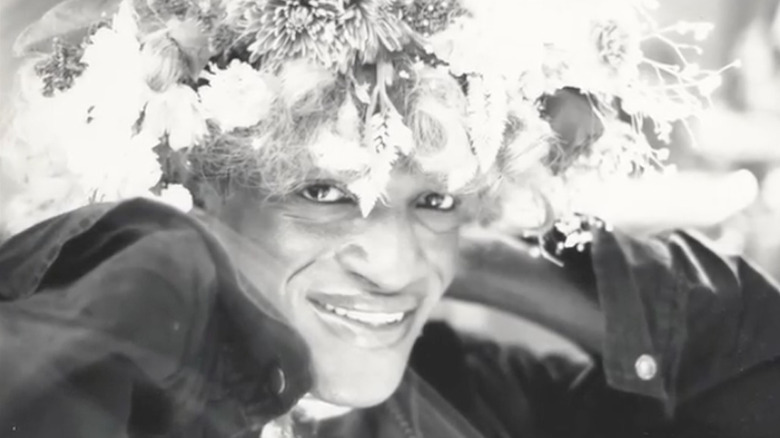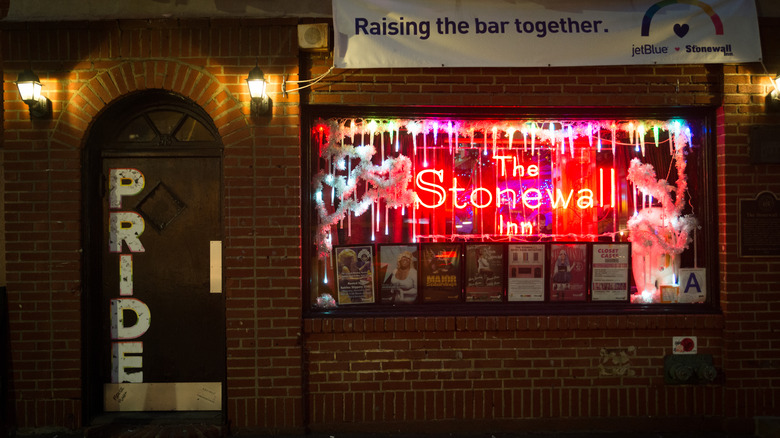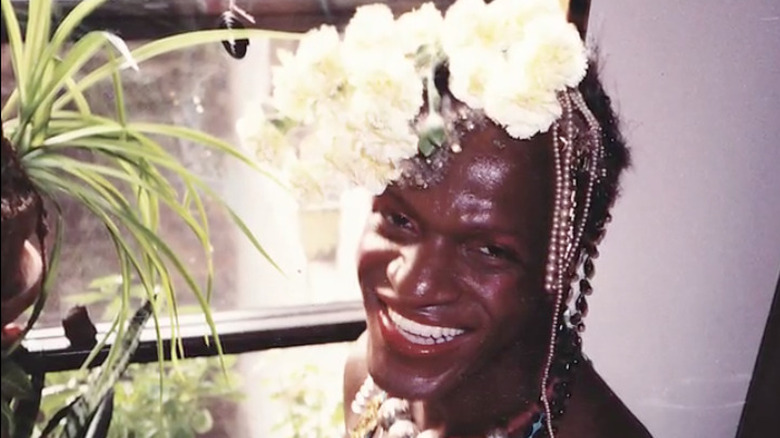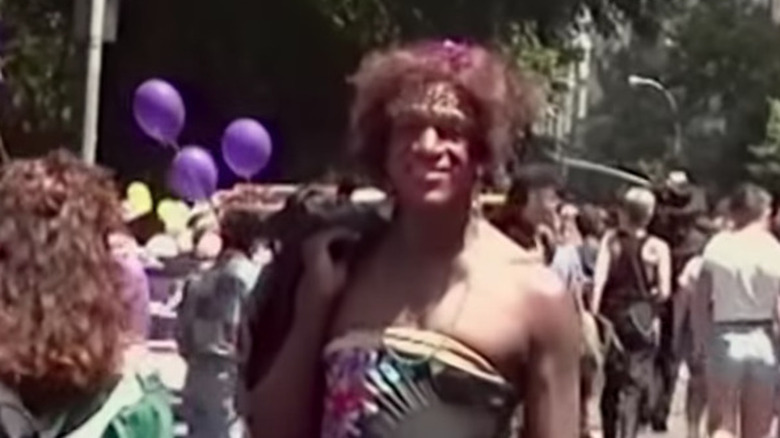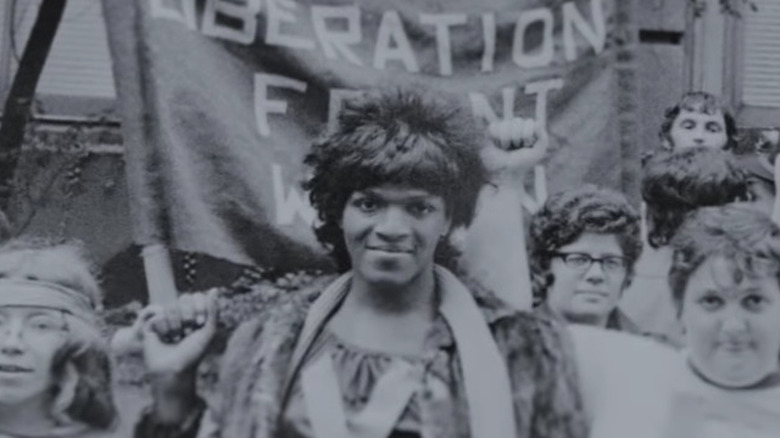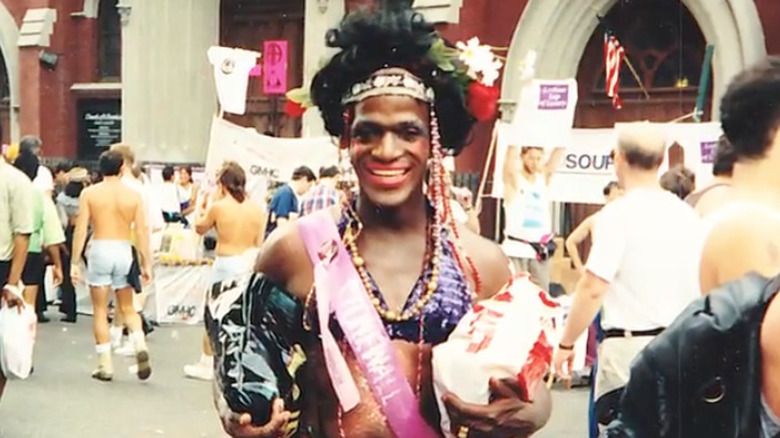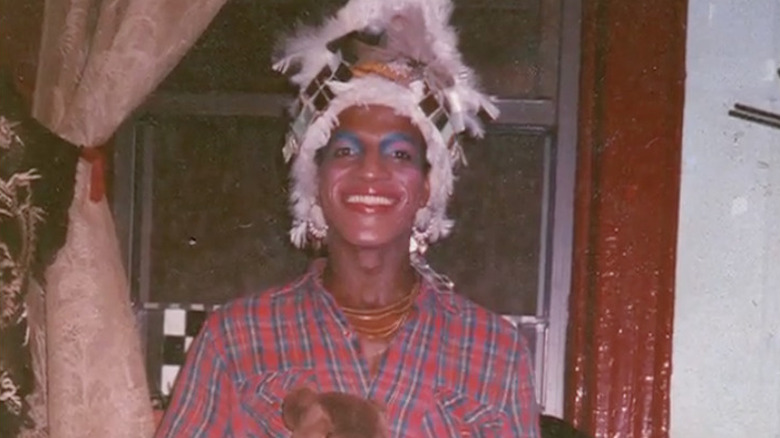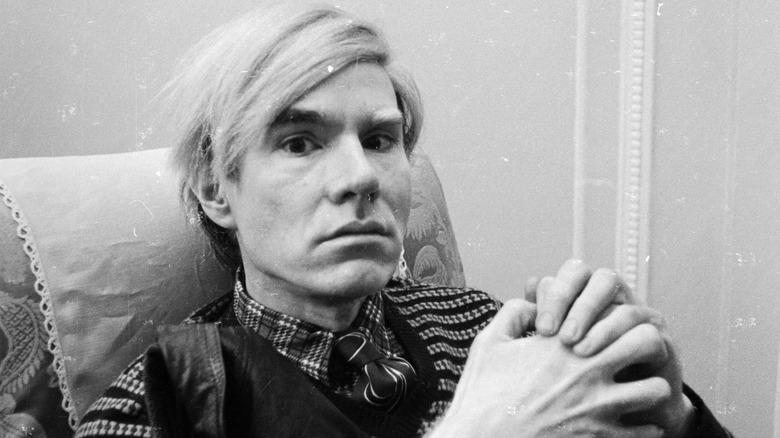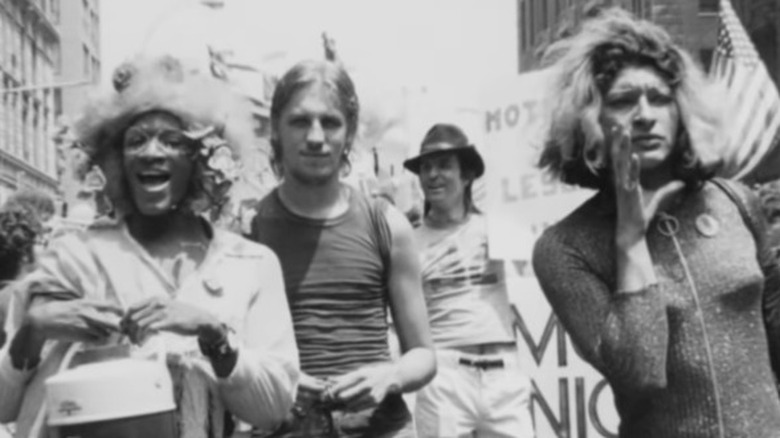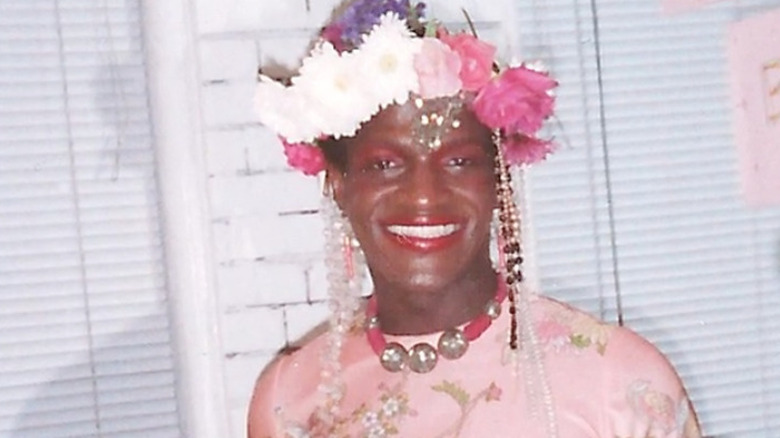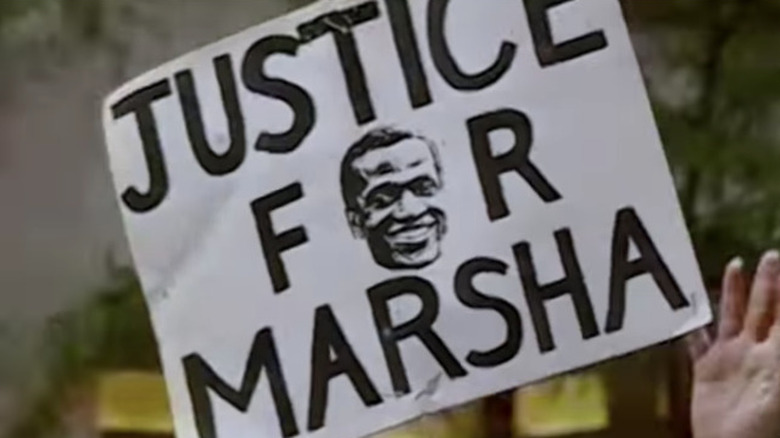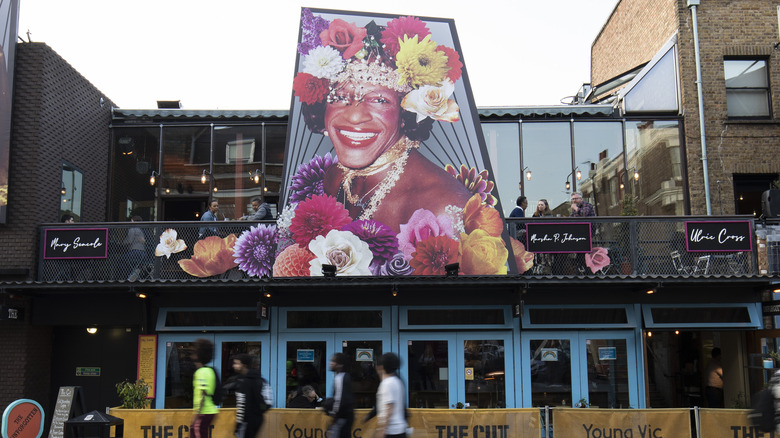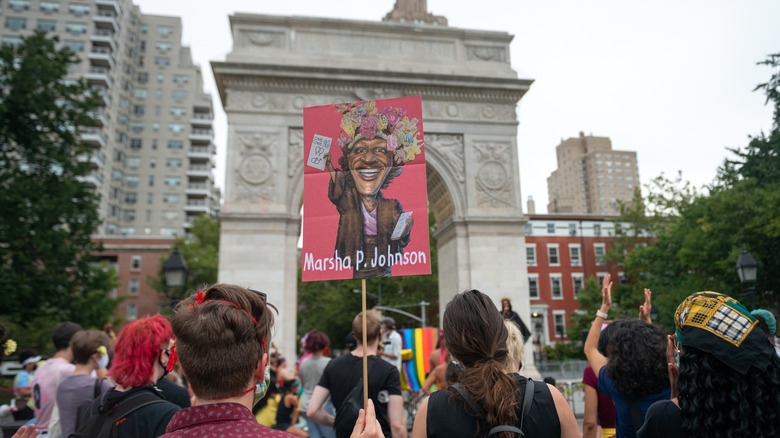The Untold Truth Of Marsha P. Johnson
Christopher Street of West Village, New York once had a mayor, and her name was Marsha P. Johnson. She was a central presence among the LGBT+ New Yorkers who sought community in that area and was a motherly figure for transgender youth who lived on the streets. One friend called her "a saint of gay life" (via New York Daily News), and she looked the part, too. She walked around the streets of New York with a crown of feathers, Christmas tinsel, or flowers and a spirited wardrobe, per Tom Fitzgerald and Lorenzo Marquez' "Legendary Children." According to her nephew, whenever Johnson visited home, it wasn't uncommon to see her wearing a hat with fruit or flowers on it, per USA Today. And according to the Village Voice, she was officially "canonized" by the drag theater troupes she performed with.
But most importantly, Johnson is remembered as a vanguard of the gay liberation movement that emerged from the 1969 Stonewall riots. Many place her inside the Stonewall Inn, where it all began, but she denied initiating the uprising, per the Making Gay History podcast. Regardless, Johnson was a fixture in the struggle for LGBT+ rights and equality, leading organizations such as the Gay Liberation Front and the Gay Action Alliance, per CNN. And she continues to inspire today. Read on for several untold truths about gay icon Marsha P. Johnson.
She was a key figure during the Stonewall riots
The night that the gay community in the West Village decided they had enough was also the night of Marsha P. Johnson's birthday party at the Stonewall Inn, according to "Legendary Children." The book describes a traditional account of Johnson's heroics during the first night of the Stonewall riots on June 28, 1969; according to authors Tom Fitzgerald and Lorenzo Marquez, Johnson triggered it. When a lesbian patron at the Stonewall Inn resisted arrest during the initial police raid and asked others at the bar for help, Johnson threw her shot glass at the bar mirror and yelled, "I want my civil rights!" Her outburst was credited for provoking the gay community's ensuing uprising. Johnson's friend and fellow activist, Sylvia Rivera, heard about the protest and joined in, excitedly calling the uprising a "revolution." Additionally, many agree that Johnson climbed a lamppost and threw an object through a police car window, per USA Today.
But Johnson herself denied instigating the riots. In an archived interview preserved on the Making Gay History podcast, Johnson said she was holding a party uptown when the riots began. She visited the bar the night before, and police lined up the patrons against a wall in order to body-search them. The Stonewall Inn was meant to remain closed, but the gay community resisted. Whatever specific actions Johnson took that night, many hail her as a leader in the gay liberation movement that emerged later.
She began wearing dresses when she was five
Marsha P. Johnson began exploring her identity at an early age and wore dresses when she was five-years-old. She was the fifth child of seven siblings. Her father worked at a General Motors factory and her mother was a housekeeper, per The New York Times. As a child, Johnson hadn't been exposed much to a world outside heterosexuality. She thought of "gayness" as a dream, since people talked about it but never lived it. As a result, Johnson said she was asexual until she left home for New York City, according to her interview with the Village Voice. Becoming a drag queen was a turning point for Johnson: "I was no one, nobody, from Nowheresville until I became a drag queen" (via Union County New Jersey).
Johnson remained close with her family and whenever she visited home for the holidays, she would bring gifts and invite needy strangers to attend family meals with her. Her nephew, Al Michaels recalls Johnson bringing 20 to 25 people home. She developed a reputation in her old neighborhood as a kind, loving person, who other people respected, even those who didn't initially like her activism. According to Michaels, Johnson effectively changed her old community and made them more accepting, per CNN.
She advocated for homeless youth and sex workers
Marsha P. Johnson lived a vulnerable life; as a sex worker, she had to hustle in the streets in order to survive. There were many like her, and she was aware of it. Johnson and fellow activist Sylvia Rivera formed an organization in order to provide refuge for transgender youth who had no choice but to resort to prostitution in order to support themselves. It was called STAR—Street Transvestite Action Revolutionaries. Johnson once said that Rivera started the organization and asked Johnson to come on board as the vice president, per the Making Gay History podcast. STAR advocated for prison reform, an end to homelessness, and liberated notions of gender and sexual identities, per Out Magazine.
In 1971, they owned a communal house on 15th street. It had four rooms, which were packed with 20 people at a single time. At times, STAR House had no electricity, and they struggled to meet the rent, according to the Village Voice. Johnson continued her job as a sex worker in order to help fund the communal home (per Vogue), but it only lasted for a year and a half. Johnson said that when the landlord landed in prison, the city government took possession of it and shut down their project, per the Making Gay History podcast. The STAR community disbanded, and Rivera earned a job as a food preparer in upstate New York.
She advocated for people with HIV/AIDS
In an interview done right before her death, Marsha P. Johnson revealed that she had been HIV positive for two years, per New York Times. Years before, Johnson had contributed her time to HIV/AIDs activism. She worked with the AIDS Coalition to Unleash Power, or ACT UP, from 1987 until her death, per Stand with Trans. She also organized AIDS vigils, per Vogue.
Johnson was also a co-founder of the Gay Liberation Front, an organization formed in the aftermath of the Stonewall riots, according to Z Magazine. Along with the GLF, she participated in a sit-in at the Weinstein Hall of New York University after the college administration canceled dances meant to be held there. It had come to light that a gay-affiliated organization was sponsoring the event, and NYU shut it down. The experience inspired them to initiate STAR—Street Transvestite Action Revolutionaries, according to Workers World. Johnson was also a founding member of the Gay Action Alliance, per CNN. The organization, which activist and best friend Sylvia Rivera was part of, worked hard to pass a city-wide ordinance to ban anti-gay discrimination. However, the final bill stopped short of protecting drag queens and transgender New Yorkers, per Z Magazine.
She performed for drag theater companies
Marsha P. Johnson is recognized mainly for her activism, but to some fortunate audiences in the 1970s and the 1980s, she was also an actress, a comic, and a singer. She started performing with the theater troupe Hot Peaches in 1972 and continued until the early 1990s, per Stand with Trans. In one show that was meant to celebrate a Pope's death, Johnson dressed up as a nun and gave a riveting performance of "Climb Every Mountain." The audience was stunned into silence and proceeded to give her a standing ovation, according to the Village Voice. She toured America and Europe with the Hot Peaches, performing songs and spoken-word poetry, per Out Magazine.
She also performed with a group called Angels of Light. Her first performance with the group occurred when she invited herself on stage, and her popular reception caused the group to make her a permanent addition. The Angels of Light was a theater troupe formed by a veteran stage performer named Hibiscus. His theater shows were free and often featured actors and dancers from the LGBT+ community, according to the Little Village Mag. Hibiscus tried writing Johnson material for her performances but eventually gave up since she was a natural impromptu performer. Hibiscus' sisters, who also performed, looked up to Johnson as a mother-like figure. They sang duets and pretended to be Hollywood greats, like Judy Garland and Barbra Streisand, according to The Downtown Pop Underground.
Her name was part of her personal motto
Marsha P. Johnson's birth name was Malcolm Michaels Jr.. Shortly after arriving in New York City, with only $15 and a bag of clothes, she started going by "Black Marsha." She later changed her last name, inspired by a Howard Johnson restaurant she visited. When she appeared in court for a soliciting charge, she told the judge that the "P" initial in her middle name stood for, "Pay it no mind." Amused, the judge let her go, according to Tom Fitzgerald and Lorenzo Marquez' book "Legendary Children." Additionally, "pay it no mind" was also her answer to questions about her gender or her identity, per Stand with Trans.
"Pay it no mind" may have stood for a grander life philosophy. According to her nephew, Al Michaels, Johnson told him, "Don't let anybody tell you what to do, be who you want to be," (via CNN). That fearless personality came with the territory. Michaels remembered that whenever Johnson visited home in Elizabeth, New Jersey, she caught eyes once she disembarked the bus, per USA Today.
She posed for Andy Warhol
Marsha P. Johnson was included in Andy Warhol's portrait series "Ladies and Gentlemen." Warhol's 1974 Polaroid project was meant to portray anonymous faces of drag queens and "transvestites," per the Tate. That meant Johnson, along with Warhol's other models, would never get their due. He withheld their names from the exhibit and paid them a one-time fee of $50 or $100, depending on the length of the shoot. Warhol earned $1 million from the project, which was one his largest ever. 268 paintings emerged from it, per Contemporary And. It wasn't until 2014 when the names of the models were finally publicized, but only 13 of the 14 models were readily identified thanks to their signatures on the Polaroids. Johnson's interview with the Village Voice noted the irony behind her sitting for Warhol, and the success that Warhol and others reaped from it: Johnson was often penniless and homeless, while her portraits sold for $1400 at a Christopher Street gallery.
The project was originally commissioned by Italian art dealer Luciano Anselmino. Warhol's assistants found subjects at the Manhattan nightclub The Gilded Grape, which was a popular place among Black and Latino drag queens and transgender women. He took an estimated 500 photographs, and his work has been celebrated again in recent years. The exhibit went on display on March 12, 2020 at London's Tate Modern, per Out Magazine.
She lived with a mental illness
In 1970, Marsha P. Johnson experienced nervous breakdowns and received treatment at psychiatric hospitals, per The New York Times. In an interview with the Village Voice, Johnson said she suffered eight breakdowns, and sometimes they would devolve into physical altercations at bars. She said that her most recent nervous breakdown resulted in a physical fight with multiple people after being denied entrance at a bar, which was commonplace for Johnson. Although she was a leading figure at the Stonewall riots, she wasn't welcome in many gay hotspots. At the time, drag queens and transgender people weren't always valued members of the gay liberation movement and were often looked down upon, but Johnson also developed a reputation as someone who would occasionally erupt in temper. Sometimes her bar fights landed her in Rikers Island.
A practicing Catholic, Johnson described lighting candles and incense in order to pray and ward off her nervous breakdowns. On occasion, she was bombarded by strange visions that invoked the end of times, which she called frightening. But Johnson was adamant that her mental struggles shouldn't overshadow her mission and activism, saying "I may be crazy, but that don't make me wrong," via (The New York Times).
She was a devout Christian
As a child, Marsha P. Johnson attended the Mount Teman African Methodist Episcopal Church in Elizabeth, New Jersey, per The New York Times. Johnson said she diligently attended church every Sunday in order to learn about Jesus. As an adult, she became Catholic and dreamt of owning her own apartment in order to build her personal altar for Catholic saints, per the Village Voice. In the documentary "Pay It No Mind: The Life and Times of Marsha P. Johnson," one of Johnson's friends said that she was once found at a Catholic church at 6 a.m., prostrated on the floor in front of a statue of the Virgin Mary. According to another friend, Johnson would never face the altar when prostrating but would face the exit, instead, as a sign of respect.
One friend recalled that Johnson said she also visited the Greek Church, the Baptist Church, and a Jewish Temple. But Johnson was drawn to Catholicism above all because of its connection to the religion of Santería, which according to Johnson, holds that all people are brothers and sisters of Christ (per "Pay It No Mind"). The idea must have seemed attractive to her because she related a similar sentiment in her frustration about the LGBT+ struggle for equality: "How many year does it take for people to see that we're all brothers and sisters and human beings in the human race?" (via "Pay It No Mind").
Her death remains unsolved
On June 26, 1992, Marsha P. Johnson gave her final interview, in which she revealed she had been HIV-positive for two years, per The New York Times. But shortly after that interview, she went missing for six days, per the BBC. On July 6, 1992, her body was found in the Hudson River. At once, her death was ruled a suicide, but her family and friends didn't believe it, and they didn't believe it was accidental. According to one report, friends saw Johnson two days before her death and said she was acting normally (via Inside Edition). Public pressure forced authorities to reclassify her death to drowning from undetermined causes. Additionally, there were various physical assault cases against members of the LGBT+ community at the time. Witnesses said they saw Johnson being harassed by a group of people at the Christopher Street Pier days before her death.
In 2012, the Manhattan District Attorney reopened the case, thanks to the efforts of activist Mariah Lopez, per the New York Daily News. Investigators determined there wasn't enough evidence to indicate foul play. They closed the case in 2013 and labeled her cause of death as "undetermined," per CBS8.
Her legacy has recently been given a spotlight
The past decade has seen a growing interest in Marsha P. Johnson and her legacy. In 2018, the New York Times published a 26-year belated obituary in her honor. In 2019, Bill De Blasio announced that New York City would honor her with a monument, per CNN. Then, there have been various documentaries and film projects. In 2017, David France debuted "The Death and Life Marsha P. Johnson" on Netflix. It premiered at the Tribeca Film Festival and focused on the efforts of investigator Victoria Cruz, who was looking into Johnson's mysterious death on behalf of the NYC Anti-Violence Project, per IndieWire. Filmmaker Reina Gossett accused France of stealing her idea and the research she had done to produce her own film with colleague Sasha Wortzel, which he refuted, per IndieWire. Gossett and Wortzel released a short fictional film about Johnson's life in the hours before the Stonewall riots, titled "Happy Birthday, Marsha!" (via the film's official website). It was released in 2017, per IMDb.
In 2012, filmmaker Michael Kasino released "Pay It No Mind: The Life And Times Marsha P. Johnson." It contained footage of her last interview in 1992, along with interviews of her friends and colleagues. In the documentary, delved into very personal aspects of her life, including her relationship with religion (per IndieWire).
A monument in New York will be dedicated to her
Before the start of Pride month in June 2019, New York Mayor Bill de Blasio promised statues of two transgender activists. Marsha P. Johnson would be among them, and her best friend, Sylvia Rivera, would be the other. It would have cost $750,000 to install and was expected to be finished by 2021, per CNN. De Blasio advertised them as the first statues in New York that would have honored trans women (per Twitter). Their planned monuments came in the midst of a campaign to increase the number of statues depicting women in New York. The announcement also came on the 50th anniversary of the Stonewall riots.
However, by 2021, the monuments hadn't arrived and progress of its installation had either stalled or canceled. Transgender activists grew impatient and erected a monument of their own: a bust of Johnson with a crown on her head in which real flowers could be strewn in. It was placed in Christopher Park, near Stonewall Inn, alongside the Gay Liberation Monument. The bust was installed without the city's approval and is intended to only stand temporarily until the city follows through with its official monument. A plaque under Johnson's bust recalls a quote of hers concerning activism and lists a few of her favorite things: poetry, flowers, space, and the color purple, per CNN.
